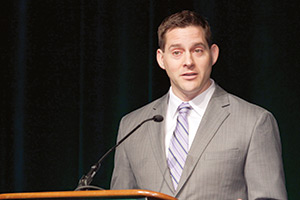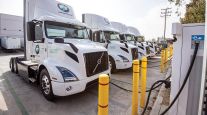Manufacturers Draw Battle Lines Over Next Phase of GHG Rules

This story appears in the May 4 print edition of Transport Topics.
The question of which areas of a truck should be the focus of forthcoming federal greenhouse-gas limits was open to debate during an industry conference as representatives from vehicle and component makers made the case that any direction regulators follow could have wide-ranging effects on fleets.
In fact, there was open disagreement among representatives from truck, engine and component makers during the Green Truck Summit, held March 3-4 at the Indiana Convention Center, about which areas of the truck matter most.
For Cummins Inc., the trucking industry’s leading manufacturer of diesels, it’s the engine.
“Keep the focus on us and take it off of our users,” said Brian Mormino, executive director of worldwide environmental strategy and compliance for Cummins, whose engines are offered in all major truck manufacturers’ vehicles. An engine-only standard could simplify compliance with the rules by keeping the focus on a single area, he said.
But that approach fails to consider potential contributions from the rest of the truck — the trailer, and aerodynamic equipment, among other things — said Amy Kopin, a regulatory compliance program manager with Daimler Trucks North America.
“There is not just one technology that will get us there,” she said. “We would like to get more credit for powertrain integration technologies.” Kopin was supported by other panelists who said during a session focused on the upcoming Phase 2 rule that many factors contribute to a truck’s efficiency and must be considered.
The standards, currently under review, are part of a program developed jointly by the U.S. Environmental Protection Agency and the National Highway Traffic Safety Administration to apply fuel-economy standards to medium- and heavy-duty trucks. The first part of the plan, or Phase 1, took effect in January 2014 and tightened emissions and mileage standards by 3% from a 2010 baseline. Another 3 percentage-point reduction is set for 2017.
The Phase 2 standards will kick in no sooner than 2020, regulators have said. The Phase 2 rules had been slated for release in March, but that release since has been delayed until June.
Phase 1 mandated both engine and vehicle standards. The open question for Mormino and others is whether that will carry over into Phase 2. Mormino believes the successful rollout of the Phase 1 standards makes a strong case for following a similar framework in Phase 2.
“The answer is embedded there in terms of how Phase 1 is doing,” he said. “Phase 1 had engine management as a big mover; the biggest areas of improvement were engines and chassis, [so] engine and chassis are a good place to start.”
This is especially true, he said, for vocational applications, where so much variety exists in terms of bodies and equipment. “If you focus on the engine, you get efficiency gains across all of these segments,” Mormino said. “It’s a very efficient way to regulate.”
But this efficiency in the regulatory process could lead to inefficiency with the vehicles, Kopin said. She believes the engine-only standard would ignore equipment options that could improve both vocational and over-the-road trucks’ compliance with the tighter restrictions. In fact, she maintained that a full-vehicle standard — one that is inclusive of driveline components, trailers, aerodynamic devices and more — can produce greater cuts in carbon dioxide emissions.
“For linehaul, there has been a divergence in engine testing and [the] real world,” she said, noting that DTNA, the parent company of Freightliner and Western Star trucks, has seen instances where engines that hit carbon-dioxide emissions limits in dynamometer testing return poor fuel economy in on-road testing. “That does not help the regulatory integrity of this program,” she said.
Furthermore, she maintained that the engine-only standard overlooks the effects transmissions can have on vehicle performance. “The engine standard does not credit transmissions, so we may have to sell technology [that] people do not want,” Kopin said. “We would like to get more credit for powertrain integration technologies and limit technologies that do not make sense for applications.”
As an example, she cited the possibility of needing to install aerodynamic equipment on vocational trucks, such as heavy-duty work trucks or pickup and delivery trucks, which typically travel at lower speeds in local and regional driving.
Volvo AB, which manufactures Volvo and Mack trucks, also supports the full-vehicle standard.
Potential consequences of using some technologies together were a concern also voiced by Michael Hayn, a senior field engineer for tire manufacturer Bridgestone Americas. He noted that while low-rolling-resistance tires can help improve fuel economy and contribute to reducing a truck’s GHG effects, equipment such as trailer skirts could impede access to tires and proper inflation maintenance.
“Almost entirely all of a tire’s contribution to fuel economy is [its] rolling resistance,” Hayn said, referring to the measurement of energy absorbed by a tire that is rolling down the road. Noting the importance of inflation checks to a tire’s performance, he suggested that any potential barriers to tire maintenance — such as aerodynamic equipment — could have a negative effect on efficiency. “We have concerns about how aerodynamic equipment will affect tire inflation maintenance,” Hayn said. In addition to inflation issues, he voiced concerns about proper heat dissipation when tires are surrounded by aero parts.
“Right now, there are hard and fast engineering formulas” for heat dissipation, Hayn said. “We have to make sure that future technologies do not have an effect on tire durability and performance.”
Getting engine technologies to work together as emissions regulations have tightened has been an ongoing issue for parts makers, said Alexander Freitag, director of diesel system engineering for Robert Bosch LLC, a supplier of automotive technology based in Farmington Hills, Michigan.
Pointing specifically to engine and powertrain components, Freitag said, “All of these things were not optimized together; they were optimized in a vacuum. We need to make sure these systems are optimized for each other.”
Going forward, that could mean changing engine combustion ratios or adopting multijet fuel injectors, he said. In addition, Freitag mentioned air management, diesel particulate filters, turbocharging and temperature control among areas that can contribute to fuel efficiency and GHG compliance.
And all of these systems must be monitored by onboard vehicle diagnostics, a consideration that will affect original equipment manufacturers, Freitag said.
“If you can meet the [nitrogen oxide] and GHG limits, then you have to monitor the engine,” he said.
That type of complexity supported Kopin’s belief that a full-vehicle standard is the best strategy. “Calibration becomes the overall term, not just for fuel but for the entire system,” she said.
Kopin added, “Stringency levels should not prevent us from selling you what you need.”




